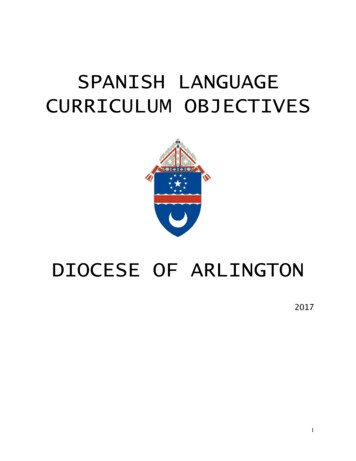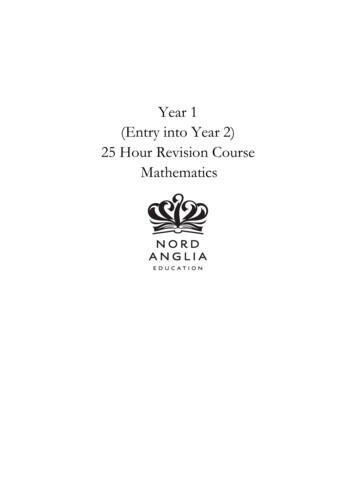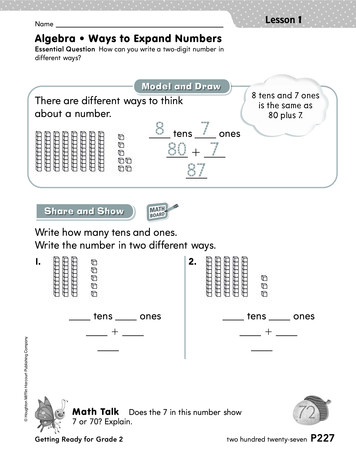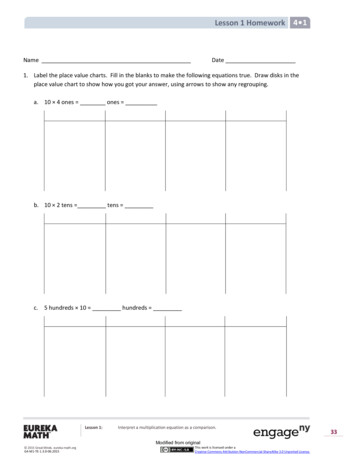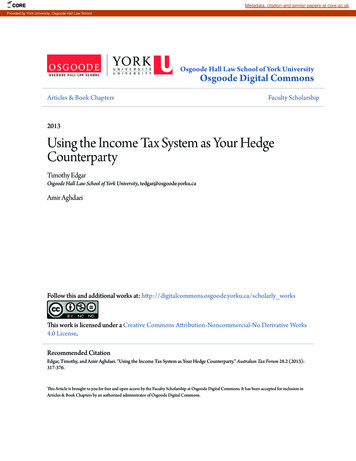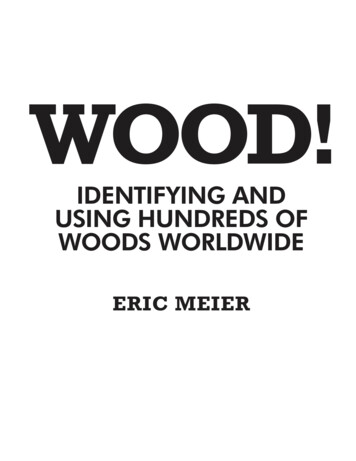
Transcription
WOOD!IDENTIFYING ANDUSING HUNDREDS OFWOODS WORLDWIDEERIC MEIER
Table of Contents1715252939253ONE Foundations:What is Wood?HARDWOODS AND SOFTWOODS TREE GROWTH SAPWOOD AND HEARTWOODPLANES OR SURFACES OF WOOD GRAIN APPEARANCE RAYSTWO Building on Basics:Wood and MoistureDIMENSIONAL SHRINKAGE WOOD FINISHES AND MOISTUREFINISHING OILY OR RESINOUS WOODSTHREE A Closer Look:Identifying WoodGREAT EXPECTATIONS FILL IN THE BLANK, OR MULTIPLE CHOICE?DEDUCTIVE WOOD IDENTIFICATIONFOUR Under the Lens:Softwood AnatomyRESIN CANALS TRACHEIDS EARLYWOOD TO LATEWOOD TRANSITIONGRAIN CONTRAST PARENCHYMA RAYSFIVE Under the Lens:Hardwood AnatomyVESSEL ELEMENTS PARENCHYMA RAYS WOOD FIBERS MONOCOTS: A SPECIAL CASESIX A Kaleidoscope:The Wood ProfilesPROFILE FIELDS EXPLAINED WOOD PROFILESAppendices andBack MatterAPPENDIX A: JANKA HARDNESS MASTERLIST APPENDIX B: MODULUS OF RUPTURE MASTERLISTAPPENDIX C: MODULUS OF ELASTICITY MASTERLIST BIBLIOGRAPHY ACKNOWLEDGMENTS INDEX
A Brief Introduction:From the AuthorWhen it comes to those who work with wood, thereseems to be generally two classes of people: scientists and craftsmen. This book was written for the latter.What I have found in my own personal observationof those that work with wood is that the first class ofpeople, the scientists, are almost drowning in knowledge. Yet the craftsmen, through no particular faultof their own, are suffering in a relative dearth of solidfacts and scientific understanding.Books on the subject of wood usage and identification have all come from one of two very opposite poles.Either there have been craft-oriented books filled withpretty pictures, but with very weak or vague and impractical statements, such as “this wood is strong,hard, and moderately stable,” or else there have beenthinly-veiled scientific books, burying the uninitiatedin grainy, black-and-white microscope images and confusing terminology.As I began researching and writing this book, manyquestions began circling in my head. “Can’t a book existthat features both vivid and accurate pictures, and alsosolid, usable facts and information on wood species?What’s practically applicable to the realm of woodworking and related trades,s, and what should be left tothe fastidious and exactingacting eyes of scientists?”In the midst of these myriad questions, Iwas debating whetherr or not to get a microscopeand delve into the world of microscopic woodidentification. Here I was, probably one of the biggest wood “nuts” around,und, utterly fascinated by themany types and varietieseties of wood, when I had anepiphany. “If I personallyally don’t have any desire to buyand learn to use a microscopeicroscope to help identify wood,then why in the worldld would Iever expect anyoneelse to either?”Mopane, Olive, Verawood, andYellow Poplar veneer fountain penAt that point, a line had been drawn in the sand. Idetermined that as I made an effort to learn (and thereafter teach others) about scientific wood data and identification, I didn’t need to consult with the “other side”to see what would be most helpful to them: I was theother side! I realized that I was a woodworker, and nota scientist—and for my purposes, that was not necessarily a bad thing.A friend of mine who works in Bible translationonce told me that in order for a translation to be optimally readable and usable for native peoples, it ultimately must be written by someone whose mothertongue is in the native language, or else it will seemawkward, foreign, and inarticulate.I am of the opinion that a very similar phenomenon happens whenever any attempt is made from thescientific community to condescend and “write down”to craftspeople: the information trying to be relayed isvery good and useful, but it’s spoken from an entirelydifferent background and mindset, and is almost completely lost in translation.It’s therefore my hope and intention with this bookto act as an interpreter in a way, and to traverse thevast and somewhat intimidintimidating territory of scientificwood knowledge, and openope a fresh pipeline of practical insight for those who stand to most directly benefit from it: woodworkers.woodworkerIn our “laboratory,” you’ll find no clean whitesmocks or stuffy collars.colla Come on in, shake thesawdust from your hhair, brush off those woodchips from your shoulders,and take a momentshouto learn a bit more about the material that’sprobably right under your nose: WOOD!
1Foundations:What is Wood?It’s common knowledge that wood comes from trees.What may not be so apparent is the structure of thewood itself, and the individual elements that makeup any given piece of lumber. Unlike a mostly homogenous piece of polystyrene, MDF, or other man-madematerial, wood is an organic material, and has manydistinct characteristics which will be helpful to learn.HARDWOODS AND SOFTWOODSAn immediate and broad distinction that can be madebetween types of trees (and wood) is the label of hardwood or softwood. This is somewhat of a misnomer,as the label is actually just a separation between angiosperms (flowering plants such as maple, oak, or rosewood), and conifers (cone-bearing trees such as pine,spruce, or fir).Hardwoods (angiosperms) have broad-leaved foliage, and tend to be deciduous—that is, they lose theirleaves in the autumn. (However, many tropical hardwood species exist which are evergreen—they maintain their leaves year-round.) Additionally, hardwoodtrees tend to have a branched or divided trunk, referredto as a dendritic form.Softwoods (conifers) tend to have needle or scalelike foliage, though in some uncommon instances,they can have rather broad, flat leaves, such as Kauri(Agathis australis). Most softwood trees are evergreen,however, a few conifers, such as Bald-cypress (Taxodium distichum), lose their foliage in the autumn, hencethe “bald” prefix in the common name.Softwoods tend to have a single, dominant, straighttrunk with smaller side branches, referred to as an excurrent form—this cone-shaped growth form helpstrees in temperate climates shed snow. Again, there areseveral conifers that are an exception to this growthform, such as Cedar of Lebanon (Cedrus libani).The confusion in labels arises in that the wood ofangiosperms is not always hard—a glaring example isBalsa (Ochroma pyramidale), which is technically classified as a hardwood. Conversely, the wood of conifers isnot necessarily always soft—an example of a relativelyhard softwood would be Yew (Taxus spp.). However,as a rule of thumb, hardwoods are of course generallyharder than softwoods, and the label is still useful todistinguish between two broad groups of trees and certain characteristics of their wood.The spruce tree pictured to the left is a good representation of a conifer with evergreen, needle-likefoliage and a single, dominant trunk. Their long,straight trunks and lightweight timber make softwoods well-suited for structural building purposes.On the right is an oak tree—with a branching form,and leaves that drop seasonally—which is characteristic of most angiosperms. Their higher densityand rich heartwood colors make hardwoods wellsuited for furniture and decorative woodwork.CHAPTER 1 Foundations: What is Wood?1
SapwoodPithHeartwoodBarkCambiumTREE GROWTHWhen considering a tree’s growth—whether a tinysapling, or a one-thousand-year-old giant—there aremany features that are common to all species. Besidesthe basics of the roots, the main stem (trunk), and thelatewood zonelatewood tends to be denser,and has smaller and less frequent pores (hardwoods) orsmaller diameter tracheids(softwoods)earlywood zoneearlywood tends to be lessdense, and has larger pores(hardwoods) or larger diameter tracheids (softwoods)Note the much wider earlywood zone in softwoods suchas the Redwood (Sequoia sempervirens), pictured on theleft (10 ), as compared to hardwoods like Paulownia(Paulownia tomentosa), on the right. When a tree growsslower than average (perhaps due to an unfavorablegrowing site), both the earlywood and latewood zonesbecome proportionately condensed. This difference explains why slower growing softwoods tend to be stronger(the weaker earlywood zones are narrower), while slowergrowing ring-porous woods like oak or ash tend to beweaker (the stronger latewood zones are narrower).2Foundations: What is Wood? CHAPTER 1In this cross section of Green Ash (Fraxinus pennsylvanica), the sapwood sectionis disproportionately wider than mosthardwood species. In some tree species,the sapwood is less than one inch thick,with the remaining trunk being composed of heartwood. Ash (Fraxinus spp.),along with maple (Acer spp.), birch (Betula spp.), and a handful of other woods,are utilized mainly for their wide, lightcolored sapwood. Conversely, the darkerheartwood is normally the commerciallyvaluable part of the tree, as in domesticspecies such as Black Walnut ( Juglansnigra) and Black Cherry (Prunus serotina).leaves and branches, there are growing points at thetips of the stems and roots, called apical meristems.These growing points, through cell division, are responsible for the vertical growth in trees.Additionally, sandwiched between the bark and theinner wood is a thin layer or sheath called the lateralmeristem or vascular cambium—usually referredto simply as the cambium. This tiny, seemingly magicallayer is responsible for practically all of the horizontalgrowth on a tree. The cambium consists of reproductivecells that, by cell division, forms new bark outward, andnew wood inward.It is the seasonal growing activity of the cambiumthat is responsible for the formation of growth ringsseen in wood. In temperate zones, the cambium is mostactive in the spring—this wood is sometimes referredto as springwood or earlywood, with growth slowingin the summer (called summerwood or latewood),and completely ceasing in the winter. These differencesin growing cycles from year to year form annual rings,which are a reasonably accurate indicator of a tree’s age.In tropical zones, where temperature and seasonal variations are minimal, wood can completely lackAt left is a 10 endgrainview of Avodire (Turræanthus africanus), a tropicalAfrican hardwood species.Note the overall lack of discernible growth rings or earlywood and latewood zones.
discernible rings, or they may correspond with variousrainy seasons, and thus are more safely referred to asgrowth rings, and not strictly as annual rings.SAPWOOD AND HEARTWOODAs the cambium forms new wood cells, they developinto different sizes, shapes, and orientations to perform a variety of tasks, including food storage, sapconduction, trunk strength, etc. When a tree is young,certain cells within the wood are alive and capable ofconducting sap or storing nutrients—this wood is referred to as sapwood.After a period of years (the number can greatly varybetween species of trees), the tree no longer needs theentire trunk to conduct sap, and the cells in the central part of the stem, beginning at the core (called thepith), begin to die. This dead wood which forms at thecenter of the trunk is thus called heartwood.The transition from sapwood to heartwood is accompanied by the accumulation of various depositsand substances, commonly referred to as extractives.Most notably, these extractives are responsible forgiving the heartwood its characteristic color: the jetblack color of ebonies (Diospyros spp.), the ruby-red ofBloodwood (Brosimum rubescens), and the chocolatebrown of Black Walnut (Juglans nigra)—each owe theirvivid hues to their respective heartwood extractives.Without extractives, the sapwood of nearly all speciesof wood is a pale color, usually ranging from white to astraw-yellow or gray color.But heartwood extractives are responsible for morethan just color: extractives increase (to varying degrees)Heartwood extractives, like those found in this sample ofTulipwood (Dalbergia decipularis), provide a cornucopia ofcolors and unique wood properties. (10 )the heartwood’s resistance to rot and decay, and give itadded stability and hardness. (Sapwood has virtuallyno resistance to decay.) From a biological standpoint,it’s easy to see the benefits that heartwood brings tothe tree as it grows taller and broader. Incidentally,many of these same benefits translate into advantagesfor woodworkers as well.However, it should be noted that the transitionarea from sapwood to heartwood, commonly referredto as sapwood demarcation, can vary from gradualto very abrupt: this can be important in wood projectswhere decay resistance is needed. A clear line of demarcation helps prevent the inadvertent inclusion of sapwood, and minimizes the risk of subsequent rotting orstructural damage.Notice the very subtletransition from sapwoodto heartwood on theupper sample of BlackWalnut ( Juglans nigra) ascompared with the verysharp line of demarcationon Amazon Rosewood(Dalbergia spruceana) onthe bottom.PLANES OR SURFACES OF WOODWhen discussing processed wood and lumber, it’s necessary to understand which surface of the wood is being referred to. Working within the scope of the growthrings and their orientation within the tree’s trunk,there are three primary planes, or surfaces, that are encountered in processed wood.The first wood surface is the endgrain (which isby far the most useful plane for wood identificationpurposes). This surface is sometimes referred to as thetransverse surface, or the cross section. This planeis mostly self-explanatory: in processed lumber, it’s thesection where a board is typically viewed on its end, andcircular growth rings may be clearly observed. For thesake of simplicity and clarity, all references in this bookwill refer to this wood plane as simply the endgrain.CHAPTER 1 Foundations: What is Wood?3
is sample of Butternut (Juglans cinerea) models thethree wood surfaces well. Note the straight and consistentgrain pattern shown on the quartersawn surface as compared to the relatively wild flatsawn surface.The second primary wood plane is the radial surface. (Think of the word radiate: this wood surface radiates out from the center of the log like spokes on a wheel,and crosses the growth rings at a more-or-less 90 angle.)This surface goes by a number of names, and is sometimescalled vertical grain, or the quartersawn section.The reason for such naming is that when sawing alog, it may be sawn into quarters along the length of thelog, forming four long, triangular, wedge-shaped pieces. Next, boards are sawn from each wedge on alternating sides, resulting in boards which (when viewed fromthe endgrain) have growth rings that are perpendicularto the face and run vertically.Again, for simplicity and clarity, most references inthis book will refer to this wood plane as the quartersawn surface. This is perhaps not the standard scientificterminology used, but it’s the most common description used among sawyers and woodworkers.The third and final surface is the tangential surface. (Think of the word tangent: the wood surface ismore or less on a tangent with the growth rings.) Thisplane is sometimes called the flatsawn or plainsawnsurface.The reason for such naming comes again from theprocess of sawing the log. The normal or “plain” methodof sawing a log is to cut straight through in a repetitioussequence, leaving the log flat throughout the entire process. (This is also sometimes called through-and-throughsawing.) Most subsequent references in this book will refer to this wood plane as the flatsawn surface.Quartersawn75316 42FlatsawnTwo methods to saw a log: on the left is an example of a quarter-sawing sequence. The log is first cut into quarters, and theneach quarter is cut on alternating sides to keep the grain as closeto vertical as possible, though the grain of the last few smallestboards aren’t perfectly vertical. On the right is an example of flat-4Foundations: What is Wood? CHAPTER 113121110987654321sawing or plain-sawing. This method produces the least amountof waste and the widest possible boards. Portions of the middlefew boards would be nearly quartersawn, though the pith andfirst few growth rings in the center (called juvenile wood) arevery unstable.
GRAIN APPEARANCEAlthough quartersawn and flatsawn surfaces are namedafter their original method of sawing, in practice, theterms typically just refer to the angle of the growthrings on a piece of processed lumber, with anythingapproaching 90 being referred to as quartersawn, andanything near 0 generally considered as flatsawn, regardless of how the log was actually milled.There’s sometimes an intermediate angle commonly called riftsawn or bastard grain, which corresponds with growth rings angled between approximately 30 to 60 . Although it’s called riftsawn, sawyerstoday will rarely, if ever, specifically saw up a log inorder to get such an angle—usually the name merelyserves as a convenient term to describe wood that isnot perfectly quartersawn.Additionally, the term face grain usually denotesthe most predominant/widest plane on any given pieceof lumber (excluding the endgrain), and does not referto any specific cut. By observing the angle of the growthrings—as when looking at a stack of boards where onlyReading the grain: note the appearance of the face grain ofthese three boards, as well as their corresponding endgrainsurfaces beneath. On the left, Beli (Julbernardia pellegriniana) is almost perfectly quartersawn, resulting in a straight,narrowly spaced, and uniform grain pattern. In the middle,Ponderosa Pine (Pinus ponderosa) is flatsawn, resulting in athe endgrain is visible—a reasonably accurate prediction of the appearance of the face of the board can bemade. Likewise, in many instances where only the facegrain of a board is visible, the endgrain may be extrapolated by “reading” the grain pattern. Each grain cut hasvarying strengths and weakness, and is used in different applications.Quartersawn boards are very uniform in appearance and are good for long runs of flooring where theboards need to be butted end-to-end with minimal disruption in appearance. Quartersawing also producesthe stablest boards with the least tendency to cup orwarp with changes in humidity, which is very usefulin many applications, such as for the rails and stiles ofraised panel doors. However, because of the extra handling involved with processing the log, and the higherwaste factor, quartersawn lumber tends to be more expensive than flatsawn lumber.Most would agree that flatsawn boards—withtheir characteristic dome-shaped cathedral grain—tend to yield the most visually striking patterns (and itcharacteristic “cathedral” grain pattern. On the right, WesternHemlock (Tsuga heterophylla) has a section on the left that isflatsawn, grading down to riftsawn, as reflected on the faceof the board, which appears flatsawn on the wild portion onthe left, and closer to quartersawn on the straighter and moreuniform portion on the right.CHAPTER 1 Foundations: What is Wood?5
should come as no surprise that many veneers are alsorotary-sliced from logs to reproduce this appearance).Flatsawn boards are also available in wider dimensionsthan quartersawn stock, and are well-suited to applications such as raised or floating panels, or other areaswhere width or appearance are important.Riftsawn wood lies somewhere between thesetwo aforementioned types. It has a uniform appearance that is very similar to quartersawn wood—andit’s nearly as stable too. On large square posts, such asthose used for table legs, riftsawn wood has the addedbenefit of appearing roughly the same on all four sides(since the growth rings on each of the surfaces are allat approximately 45 angles to the face), whereas quartersawn squares would have two sides that display flatsawn grain, and two with quartersawn grain.RAYSA discussion on quartersawn and riftsawn lumberwould not be complete without mentioning the mostsignificant visual distinction between the two: presence (or absence) of rays—or perhaps more accurately,the conspicuous presence of rays on the face of the board,known commonly as ray fleck, or ray flakes.Note the lighter colored rays radiating out from the pith inthis sample of Holm Oak (Quercus ilex). Ray fleck is only apparent in areas on the face of the board that are nearly perfectly quartersawn, with the flat and rift sawn areas on the lefttwo thirds obscuring the rays under a lower profile.6Foundations: What is Wood? CHAPTER 1In the same way that quartersawn surfaces radiateout from the center of the log (hence the term radialsurface), rays are also oriented in the same direction;for this reason, although rays are always technicallypresent in the wood, they become most visible and pronounced on quartersawn surfaces. (Additionally, endgrain drying checks also tend to occur along the rays.)The rays seen in this 1 endgrain view of Lacewood(Panopsis spp.) are so large and prevalent, they could easily be mistaken for growth rings.But even though virtually all woods have rays, onlyspecies with wide, conspicuous rays will produce dramatic ray fleck on the quartersawn surface. Perhapsthe largest rays are found on woods like Leopardwood(Roupala montana) and Lacewood (Panopsis spp.), sonamed for the superb ray fleck seen on their quartersawn surfaces.Domestic woods like oak (Quercus spp.) and sycamore (Platanus spp.) also have easily observable rays.Other woods have more modest ray fleck, such as cherry (Prunus spp.) or elm (Ulmus spp.). Many other species, such as ash (Fraxinus spp.), walnut (Juglans spp.),and chestnut (Castanea spp.), as well as most softwoods, lack visible ray fleck patterns.It should be noted that ray fleck is not always greeted with enthusiasm: the very same feature that mayentice a person to purchase quartersawn oak may alsorepel another away. In some instances—such as forhardwood floors where a subdued or consistent grainpattern may be desired—ray fleck may be viewed asobjectionable or distracting. For this reason, riftsawnwoods, most commonly White Oak (Quercus alba), areoccasionally offered as a means to reap the benefits ofuniformity and stability of quartersawn lumber without the sometimes distracting rays.
2Building on Basics:Wood and MoisturePerhaps the most important aspect of woodworking deals with the relationship between wood andmoisture. The most skilled builder may plane, chisel, orotherwise finesse a wood project into a flawless work,but if wood moisture is ignored, all will be for naught.Joints will pop loose, wide glued-up panels will warpor split, and flooring planks will retract and reveal unsightly gaps (or expand and buckle).A fundamental fact is that wood is hygroscopic.This means that wood, almost like a sponge, will gain orlose moisture from the air based upon the conditions ofthe surrounding environment. But not only does woodgain or lose moisture, but it will also expand or contractaccording to its moisture level. It’s this swelling andshrinking in finished wood products, often referred toThe panel of this old church door has a split. The dooris located next to a radiator, exposing the wood to extremely low humidity levels, which more than likelycaused the panel to contract and eventually split.as the wood’s movement in service, that’s responsible for so much mischief and so many malfunctions inwoodworking.When a tree is first felled, it’s considered to be inthe green state, denoting its maximum moisture level. This moisture exists in two different forms: as freewater that’s contained as liquid in the pores or vesselsof the wood itself, and as bound water that’s trappedwithin the cell walls.Once a fresh log or piece of lumber is cut and exposed to the air, it will immediately begin losing freewater. At this point, the wood does not yet contract orotherwise change in dimension since the fibers are stillcompletely saturated with bound water. Once all thefree water has been lost, the wood will reach what iscalled the fiber saturation point, or simply FSP.Below the FSP, the wood will then begin to losemoisture in the form of bound water, and an accompanying reduction in the wood’s physical volume willoccur. In a practical sense, the wood at this point is nowconsidered to be in a state of drying.During drying, not all of the bound moisture willbe lost: just how much water is lost will ultimately depend upon the temperature and relative humidity (RH)of the surrounding air. At 100% rh, no bound waterwill be lost. At 0% rh, all the bound water in the woodwill be lost, a condition known as ovendry (so-calledbecause a kiln or oven is typically required to completely drive out all moisture).The amount of water in a given piece of wood is expressed as a percentage of the weight of the water ascompared to its ovendry weight. Some species of trees,when they are initially felled, may contain more waterby weight than actual wood fiber, resulting in a moisture content (MC) over 100%.CHAPTER 2 Building on Basics: Wood and Moisture7
Yellow BirchBetula alleghaniensisDISTRIBUTION: Northeastern North AmericaTREE SIZE: 65–100 ft (20–30 m) tall,2–3 ft (.6–1 m) trunk diameterAVERAGE DRIED WEIGHT: 43 lbs/ft3 (690 kg/m3)SPECIFIC GRAVITY (BASIC, 12% MC): .55, .69JANKA HARDNESS: 1,260 lbƒ (5,610 N)MODULUS OF RUPTURE: 16,600 lbƒ/in2 (114.5 MPa)ELASTIC MODULUS: 2,010,000 lbƒ/in2 (13.86 GPa)CRUSHING STRENGTH: 8,170 lbƒ/in2 (56.3 MPa)SHRINKAGE: Radial: 7.3%, Tangential: 9.5%,Volumetric: 16.8%, T/R Ratio: 1.3COLOR/APPEARANCE: Heartwood is light reddishbrown, with nearly white sapwood. Occasionally figuredpieces are seen with a wide, shallow curl similar to the curlfound in Black Cherry (Prunus serotina). There is very little color distinction between annual growth rings, givingbirch a somewhat dull, uniform appearance.GRAIN/TEXTURE: Grain is generally straight or slightlyWORKABILITY: Generally easy to work with hand andmachine tools, though boards with wild grain can causetearout during planing. Turns, glues, and finishes well.ALLERGIES/TOXICITY: Birch in the Betula genus hasbeen reported as a sensitizer; can cause skin and respiratory irritation.PRICING/AVAILABILITY: Very common as plywood; alsoavailable in board form. Prices are moderate for a domestic hardwood.wavy; fine, even texture with low natural luster.SUSTAINABILITY: Not listed in the CITES Appendices,ROT RESISTANCE: Rated as perishable; poor insect/or on the IUCN Red List of Threatened Species.borer resistance.COMMON USES: Plywood, boxes, crates, turned objects,interior trim, and other small specialty wood items.COMMENTS: Frequently used worldwide for veneer andENDGRAIN (10 )Porosity:diffuse-porousArrangement:mostly radial multiplesVessels: small tomedium, numerousParenchyma:marginal, andsometimes diffusein-aggregatesRays: narrow, fairlyclose spacingOdor: noneNotes: individualBetula species cannotbe reliably separatedplywood. One of the highest grades of plywood—withno inner softwood plies as fillers—is referred to as Baltic Birch.It’s technically nott a particular species, butut is ageneral designationon ofplywood from Russiaand nearby Baltic statessuch as Finland. The pliesin these higher grades arethinner and morere numerous, impartingtinggreater stiffness andstability.Masur Birch vaseby Steve Earis
Masur BirchBetula pendula var. carelicapendula). It’s also sometimes known as Karelian Birch—with Karelia being a region between Finland and Russiawhere the figured wood is sometimes found.Once surmised to have been caused by the boringlarvae of a certain beetle, Masur Birch has been shownto be hereditary,* classifying the name of the variant asBetula pendula var. carelica. Regardless of the exact cause,the resulting figure and appearance is very similar to burlwood or birdseye maple, though of a different origin.LOOKALIKES: Maple (Acer spp.) and birch may be distin-Masur Birch is not a particular species of birch, but israther a grain figure that is most commonly seen inDowny Birch (Betula pubescens) and Silver Birch (BetulaRELATED SPECIESguished by comparing the size of their pores in relation tothe rays (when observed from the endgrain). In maple, thewidest rays are about the same width as the pores, whilein birch the rays are noticeably narrower than the pores.* Risto Hagqvist, Curly Birch (Betula pendula var. carelica) and its Management in Finland, (Karkkilantie: Finnish Forest Research Institute, UREELASTICMODULUSCRUSHINGSTRENGTH33 lbs/ft3830 lbƒ8,980 lbƒ/in21,235,000 lbƒ/in26,400 lbƒ/in2Alder-Leaf BirchBetula alnoides(530 kg/m3)(3,690 N)Sweet BirchBetula lenta46 lbs/ft3(735 kg/m3)1,470 lbƒ16,900 lbƒ/in2 2,170,000 lbƒ/in28,540 lbƒ/in2Alaska Paper BirchBetula neoalaskana(610 kg/m3)830 lbƒ13,600 lbƒ/in2 1,900,000 lbƒ/in27,450 lbƒ/in2970 lbƒ13,100 lbƒ/in2 1,580,000 lbƒ/in2No dataavailableRiver BirchBetula nigraPaper BirchBetula papyriferaSilver BirchBetula pendulaGray BirchBetula populifolia7038 lbs/ft337 lbs/ft3(6,540 N)(3,690 N)(590 kg/m )(4,320 N)**estimated38 lbs/ft33(61.9 MPa)(116.6 MPa)(93.8 MPa)(90.3 MPa)(8.52 GPa)(11.59 GPa)(13.10 GPa)(10.90 GPa)(44.1 MPa)(58.9 MPa)(51.4 MPa)3(610 kg/m )910 lbƒ(4,050 N)12,300 lbƒ/in2 1,590,000 lbƒ/in25,690 lbƒ/in240 lbs/ft31,210 lbƒ16,570 lbƒ/in2 2,024,000 lbƒ/in23(640 kg/m )35 lbs/ft3(560 kg/m3)(5,360 N)760 lbƒ(3,380 N)(84.8 MPa)(10.97 GPa)(39.2 ��13%T/R c–15.6%T/R c–16.7%T/R c–13.5%T/R c–16.2%T/R Ratio–1.4114.3 MPa)(13.96 GPa)No dataavailableNo dataavailable9,800 lbƒ/in21,150,000 lbƒ/in24,870 �14.7%T/R Ratio–1.8(67.6 MPa)(7.93 GPa)(33.6 MPa)
AfricanPadaukPterocarpus soyauxiiDISTRIBUTION: Central and tropical west AfricaTREE SIZE: 100–130 ft (30–40 m) tall,2–4 ft (.6–1.2 m) trunk diameterAVERAGE DRIED WEIGHT: 47 lbs/ft3 (745 kg/m3)SPECIFIC GRAVITY (BASI
Books on the subject of wood usage and identifica-tion have all come from one of two very opposite poles. Either there have been craft-oriented books filled with pretty pictures, but with very weak or vague and im-practical statements, such as "this wood is strong, hard, and moderately stable," or else there have been

